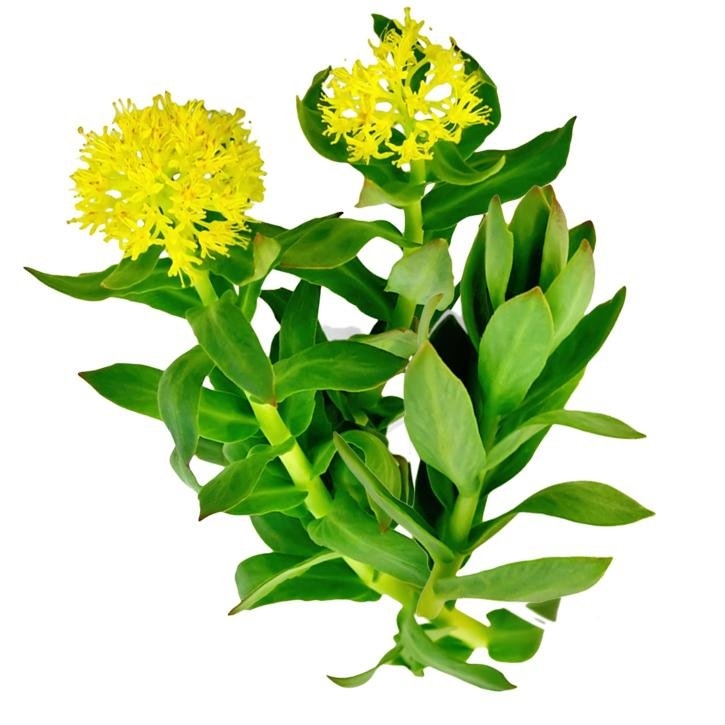Rhodiola rosea L.
Description
It is a herbaceous, robust and hemicryptophyte plant, which means it loses its aerial part during the unfavorable season. It reaches 30 cm in height, generally around 20-30 cm. Its spindle-shaped root becomes thicker in the upper part, where it develops some short rhizomes from which its gathered, cylindrical, thick and erect, unramified stems grow surrounded by leaves, which are arranged in spiral pattern tightened around it. Its leaves are succulent, of 0.7 to 3.5 of length and 0.5 to 1.8 cm of width, and the ones that grow in the high part of the stem are bigger. Their shape is variable, depending on the geographical location. The leaves from the southern populations are longer and narrower, linear-oblong, and the ones from the northern populations are shorter and wider, orbicular and a little apiculate. They are glabrous and waxy, with the full or irregularly serrated edge, of glaucous color (green-blue). It is a dioecious plant, with separated male and female individuals. Rhodiola plants with hermaphroditic flowers are found very rarely. Male plants are very vigorous. Flowers blossom from June to August in inflorescences in compact, apical, generally tetramerous although rarely pentramerous cymous. Male flowers are yellow or orange and female flowers are purple or maroon, almost black. Its fruit consists in four red follicles, of 6 to 12 mm of length. Seeds are small, of 1 to 1.5 mm, brown, long, with a winged end. Once the fruits have ripened, rhodiola leaves and stems become pink and wither. Buds stay in the rhizomes and will renovate the plant in the following spring. If the plant is damaged, it emits a smell very similar to rose scent.
Rhodiola is a plant from the family Crassulaceae, which grows in the cold regions of the Northern Hemisphere. These areas include the Arctic coast and surrounding countries, as well as the alpine zone of the highest mountains, such as the Himalaya, the Rocky Mountains, the Alps, the Pyrenees and the Carpathians. Rhodiola grows in rock corbels and crevices of mountains, in peaty edges of streams and in tundra. This plant lives in northern Europe and Asia, in eastern North America and in the alpine zone of mountains. It can be found in Greenland, Iceland, Scandinavia, in the north of the British Islands, Pyrenees, Apennine Mountains, Alps, Carpathians, Rocky Mountains, and Himalaya.
Part used
The rhizome and the root.
Indications
- Relief for asthenia symptoms, such as fatigue and weakness.
- Students in exam periods.
- Convalescence.
- Sportspeople.
- Low mood, anxiety and mild depression.
Bibliography
Risco E. Farmacología y clínica de la raíz de rodiola frente al estrés. Revista de Fitoterapia 2011; 11 (2): 101-117.
Fintelmann V, Gruenwald J. Efficacy and tolerability of a Rhodiola rosea extract in adults with physical and cognitive deficiencies. Adv Ther 2007; 24 (4): 929-39.
Bystritsky A, Kerwin L, Feusner JD. A pilot study of Rhodiola rosea (Rhodax) for generalized anxiety disorder (GAD). J Altern Complement Med 2008; 14 (2): 175-80.
Amsterdam JD, Panossian AG. Rhodiola rosea L. as a putative botanical antidepressant. Phytomedicine. 2016; 23 (7): 770-83.
Nabavi SF, Braidy N, Orhan IE, Badiee A, Daglia M, Nabavi SM. Rhodiola rosea L. and Alzheimer's Disease: From Farm to Pharmacy. Phytother Res. 2016; 30 (4): 532-9.
Recio MC, Giner RM, Máñez S. Immunmodulatory and antiproliferative properties of Rhodiola species. Planta Med. 2016; 82 (11-12):952-60.
